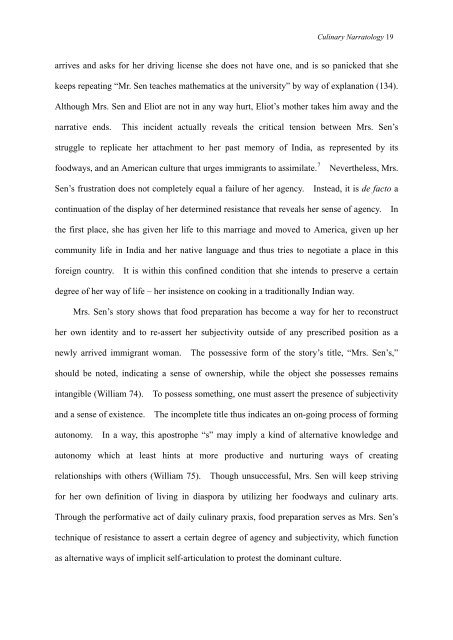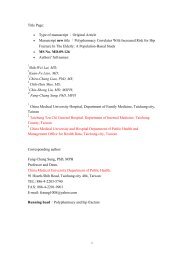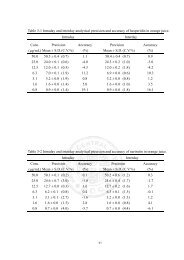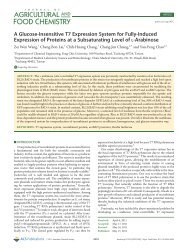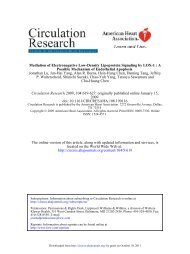Culinary Narratology in Everyday Life: Foodways and Identity ...
Culinary Narratology in Everyday Life: Foodways and Identity ...
Culinary Narratology in Everyday Life: Foodways and Identity ...
You also want an ePaper? Increase the reach of your titles
YUMPU automatically turns print PDFs into web optimized ePapers that Google loves.
<strong>Cul<strong>in</strong>ary</strong> <strong>Narratology</strong> 19<br />
arrives <strong>and</strong> asks for her driv<strong>in</strong>g license she does not have one, <strong>and</strong> is so panicked that she<br />
keeps repeat<strong>in</strong>g “Mr. Sen teaches mathematics at the university” by way of explanation (134).<br />
Although Mrs. Sen <strong>and</strong> Eliot are not <strong>in</strong> any way hurt, Eliot’s mother takes him away <strong>and</strong> the<br />
narrative ends. This <strong>in</strong>cident actually reveals the critical tension between Mrs. Sen’s<br />
struggle to replicate her attachment to her past memory of India, as represented by its<br />
foodways, <strong>and</strong> an American culture that urges immigrants to assimilate. 7<br />
Mrs. Sen’s story shows that food preparation has become a way for her to reconstruct<br />
her own identity <strong>and</strong> to re-assert her subjectivity outside of any prescribed position as a<br />
newly arrived immigrant woman. The possessive form of the story’s title, “Mrs. Sen’s,”<br />
should be noted, <strong>in</strong>dicat<strong>in</strong>g a sense of ownership, while the object she possesses rema<strong>in</strong>s<br />
<strong>in</strong>tangible (William 74). To possess someth<strong>in</strong>g, one must assert the presence of subjectivity<br />
<strong>and</strong> a sense of existence. The <strong>in</strong>complete title thus <strong>in</strong>dicates an on-go<strong>in</strong>g process of form<strong>in</strong>g<br />
autonomy. In a way, this apostrophe “s” may imply a k<strong>in</strong>d of alternative knowledge <strong>and</strong><br />
autonomy which at least h<strong>in</strong>ts at more productive <strong>and</strong> nurtur<strong>in</strong>g ways of creat<strong>in</strong>g<br />
relationships with others (William 75). Though unsuccessful, Mrs. Sen will keep striv<strong>in</strong>g<br />
for her own def<strong>in</strong>ition of liv<strong>in</strong>g <strong>in</strong> diaspora by utiliz<strong>in</strong>g her foodways <strong>and</strong> cul<strong>in</strong>ary arts.<br />
Through the performative act of daily cul<strong>in</strong>ary praxis, food preparation serves as Mrs. Sen’s<br />
technique of resistance to assert a certa<strong>in</strong> degree of agency <strong>and</strong> subjectivity, which function<br />
as alternative ways of implicit self-articulation to protest the dom<strong>in</strong>ant culture.<br />
Nevertheless, Mrs.<br />
Sen’s frustration does not completely equal a failure of her agency. Instead, it is de facto a<br />
cont<strong>in</strong>uation of the display of her determ<strong>in</strong>ed resistance that reveals her sense of agency. In<br />
the first place, she has given her life to this marriage <strong>and</strong> moved to America, given up her<br />
community life <strong>in</strong> India <strong>and</strong> her native language <strong>and</strong> thus tries to negotiate a place <strong>in</strong> this<br />
foreign country. It is with<strong>in</strong> this conf<strong>in</strong>ed condition that she <strong>in</strong>tends to preserve a certa<strong>in</strong><br />
degree of her way of life – her <strong>in</strong>sistence on cook<strong>in</strong>g <strong>in</strong> a traditionally Indian way.


